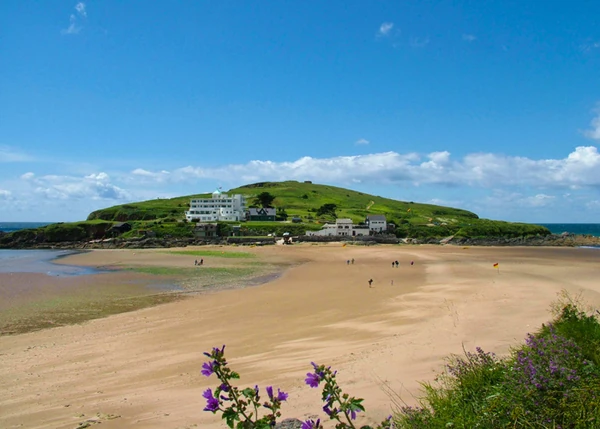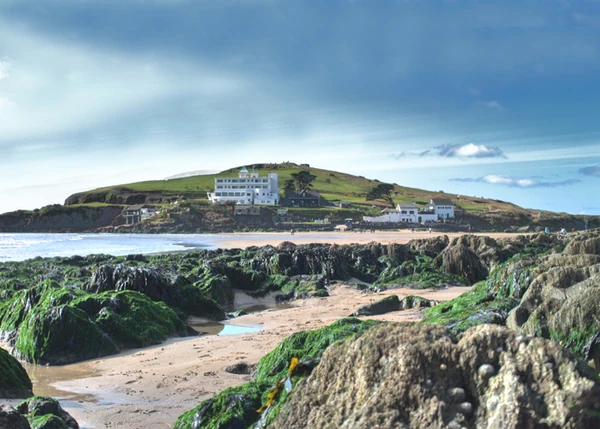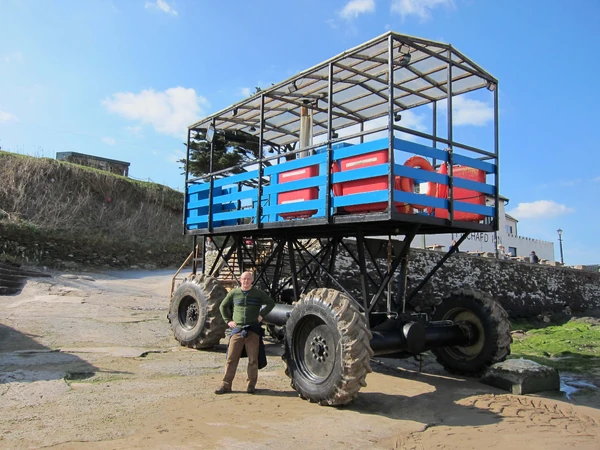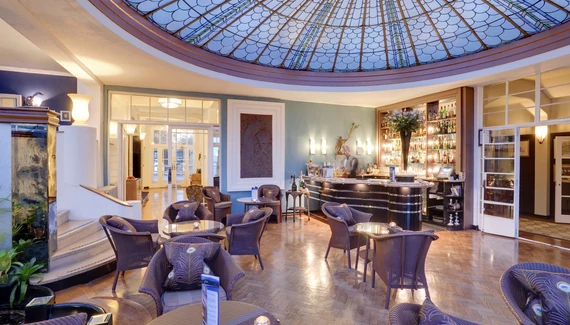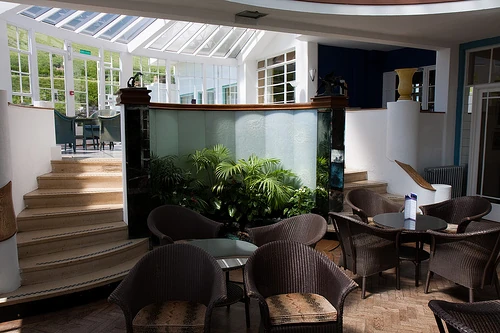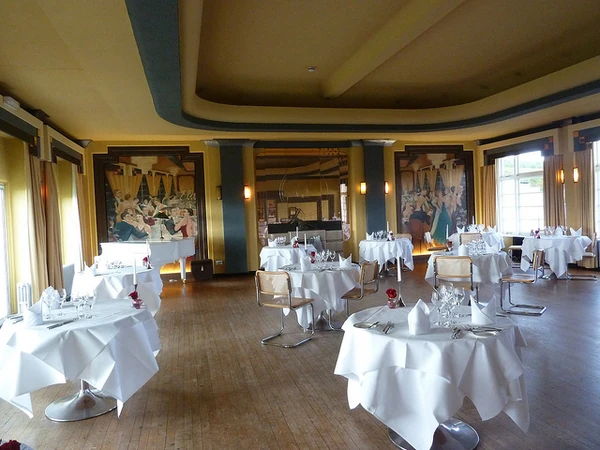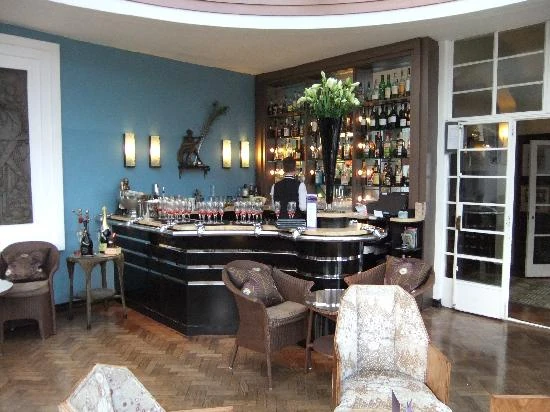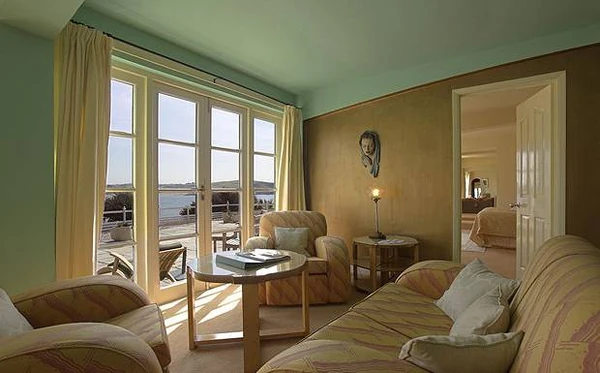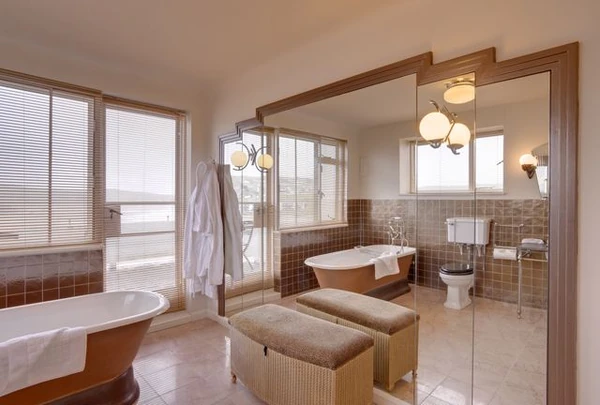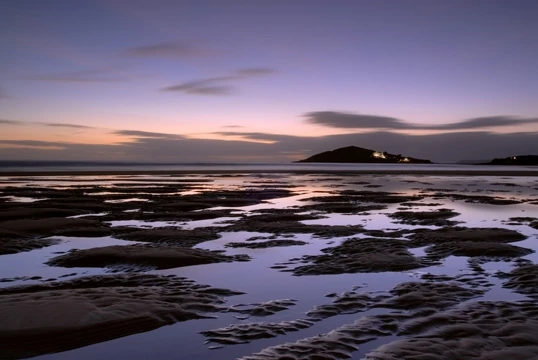Burgh Island is a small tidal island off the coast of South Devon in England near to the small seaside village of Bigbury-on-Sea. There are several buildings on the island, the largest being the Art Deco Burgh Island Hotel. The other buildings are three private houses, and a public house, the Pilchard Inn, run by the hotel.
History[]
The early history of the island is unclear, however it is mentioned in early records and on maps as St Michael's Island. Later the name changed to Borough Island, eventually being corrupted to Burgh. As late as 1947 an Ordnance Survey map refers to the island as Borough Island. In 1908 a postcard produced by Stengel & Co Ltd of London referred to it as Burr Island. A map published in 1765 shows "Borough or Bur Isle".
It is believed a monastery was established on the island, most of the remains of which may lie beneath the current hotel. The ancient Pilchard Inn may have started life as the guest lodgings for the monastery.
A small, perhaps transient, population of fishermen occupied the island following the dissolution of the monastery, specialising in pilchard fishing. There are the remains of a chapel a-top the island, which was later became a "huers hut" — a place where fishermen would make a "hue and cry" call to inform other fishermen of shoals of pilchards. During this period smuggling, wrecking and piracy were common, benefiting from a natural barrier for half the day.
Fears of German landing forces using the island as a beachhead during World War II resulted in the area's fortification with anti-tank defences as well as two pill boxes, positioned on either side of the causeway. An observation post was also established on the summit to monitor the coastline.
The Hotel[]
The Burgh Island Hotel is a hotel on Burgh Island, Devon in England. In the 1890s, the music hall star George H. Chirgwin built a prefabricated wooden house on the island, which was used by invited guests for weekend parties. The island was sold in 1927 to the filmmaker Archibald Nettlefold of Nettlefold Studios, and the heir to the Guest, Keen and Nettlefolds engineering firm, who built a more substantial hotel in the Art Deco style, which became a popular destination in the 1930s. Additions were made through the 1930s, including a room created from the captain's cabin of the warship HMS Ganges (1821). The hotel is now a Grade II Listed Building.
During World War II, the hotel was used as a recovery centre for wounded RAF personnel. The top two floors of the hotel were damaged by a bomb during the conflict. Despite being repaired, it suffered a period of post war decline after being converted to self-catering apartment accommodation. The hotel was restored during the early nineties by Tony and Beatrice Porter.
Notable visitors[]
Burgh Island Hotel is closely linked to the crime novelist Agatha Christie, as it inspired the settings for both And Then There Were None and the Hercule Poirot mystery Evil Under the Sun. The 2001 TV adaptation of Evil Under the Sun used the island as a filming location. Several scenes from the BBC’s 1987 dramatisation of Christie’s story Nemesis were also filmed in the hotel. In 1994 'Somewhere Over the Rainbow', an episode of the television series Lovejoy, was set and filmed on the island. The island was also the location for GMTV's Inch-loss Island slimming feature in 2008, as it was for the original series in 2001. The climactic scene of the 1965 British film Catch Us If You Can (featuring The Dave Clark Five) takes place at the island.
Other famous visitors to the Burgh Island Hotel have included The Beatles who used the hotel when they were playing a concert in Plymouth. Noël Coward visited the hotel, intending to stay three days and ended up staying three weeks. Other guests who have reputedly used the hotel include Edward VIII and Mrs. Simpson and it is said that Eisenhower and Churchill met there in the weeks leading up to the D-Day invasion.
Transport[]
The island is approximately 250 metres (270 yards) from the mainland at Bigbury-on-Sea and is approachable on foot at low tide. At high tide, the Sea Tractor, which is operated by the hotel, transports pedestrians back and forth. The original vehicle was constructed in 1930; the current, third generation tractor dates from 1969. The vehicle drives across the beach with its wheels underwater on the sandy bottom while its driver and passengers sit on a platform high above. Power from a Fordson tractor engine is relayed to the wheels via hydraulic motors.
Footpaths[]
The island has an extensive network of footpaths and the owner until 2003 was a keen hiker who welcomed walkers. The new owners, however, erected signs closing footpaths and obtained an exemption from the public "rights to roam" enabled in the Countryside and Rights of Way Act 2000. The exemption was overturned, except for the routes closest to the hotel, in 2006.
Burgh Island in media[]
- In 2005 a documentary about Burgh Island was made for Channel 4 as episode 1 of a 7 part series on famous British hotels: "Checking into History" (see IMDb tt1020605).

